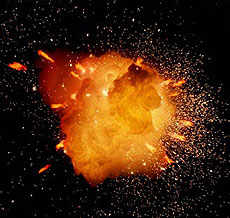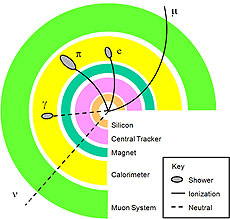Subatomic bomb squad
 |
|
Particle physics collisions occur quickly and, like bomb investigators, scientists figure out what happened by looking at how the debris interacted with nearby material.
|
To identify a particle, sometimes we need to look at the particle's decay products and work backwards. We also need to do this sometimes to determine what is going on in the collision itself. If we look at a Higgs boson decaying into two electrons and two muons, we can't hold onto one of those particles and put it under a microscope. Instead, we look at how they interact with the detector and use that to put together the pieces of the puzzle.
Imagine that you're a bomb squad investigator, and a house blew up (thankfully, without injuring anyone). How would you figure out what caused the explosion? First, you'd look at the damage to the house. You'd take a closer look at the room with the most damage. Since you weren't there when the explosion occurred, you'd need to see how the debris interacted with the environment. If the stove blew up, the debris would have punched through walls or dented the refrigerator. By examining the resulting damage, you can learn a lot. Did the explosion go mostly upwards, sideward or was it symmetrical? Did the debris punch through the walls entirely or was it stopped by just one layer of sheetrock? Was the refrigerator knocked over or just dented some? You could determine that the stove blew up due to a gas leak, how much gas was involved, and possibly determine whether the gas leak was in the oven or the burners on top or in the gas pipe coming into the stove.
 |
|
This figure shows the basics of how we identify the particles we observe in our detector.
|
As an investigator, you need to know a lot about the material surrounding the explosion and how fast-moving matter interacts with that material. From there, you can figure out what happened, even if the stove is totally destroyed.
In physics, we do essentially the same thing. Some particles, like muons, lose a small amount of energy over a very long distance. Called ionization, the slow energy loss allows the muons to punch all the way through a detector. Neutrinos don't interact at all and escape undetected. Electrically neutral particles, like photons, do not ionize, but travel unimpeded until they undergo a drastic interaction. Electrons and photons can interact with the electrons of atoms or the electric field of the atomic nucleus and deposit a lot of energy in a very short distance. In contrast, particles such as charged pions and protons interact most when they directly hit an atomic nucleus. The debris of the first collision causes secondary collisions with other atomic nuclei, causing the pions and protons to lose their energy over the distance of a couple of feet.
If you can identify these characteristics and know that charged particles move in a curved path in a magnetic field, you can see how scientists look at the final pieces to reconstruct a particle collision.
Want a phrase defined? Have a question? Email Fermilab Today.
—Don Lincoln
|